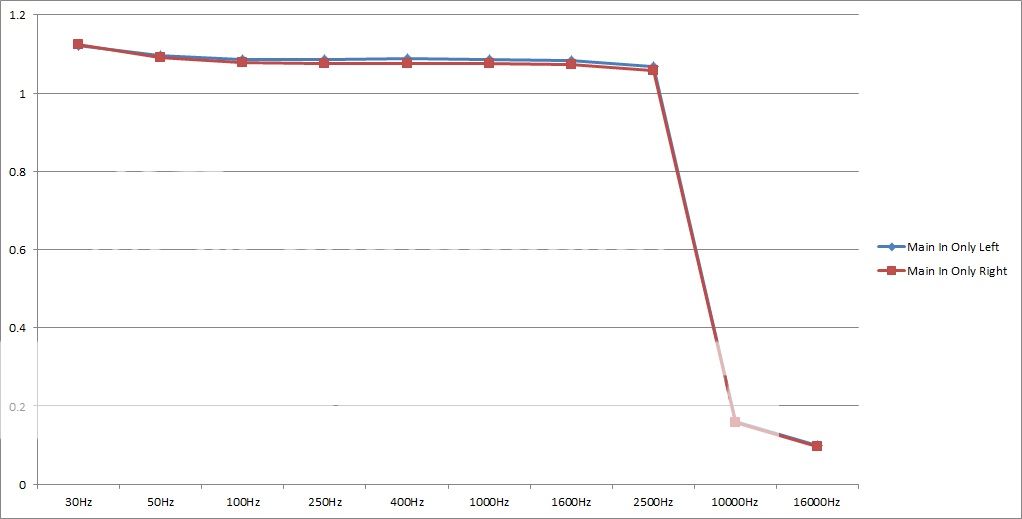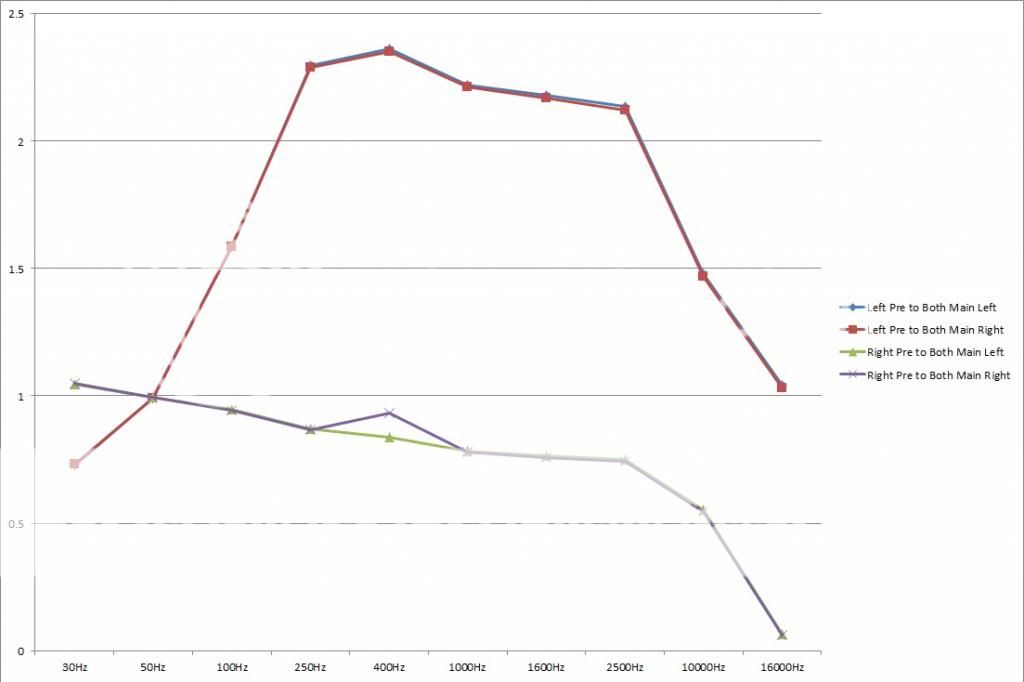I just finished repairing a sub for a friend and deposited that money into my scope fund
I did like your simplified description of th action of the resistors and caps to ground... I think, unless I find a failed resistor that I haven't yet checked, I'm going to replace all those caps.
Fair enough
Just to go over what we know and for you to re confirm things.
The preamp to power amp feeds have been swapped and so we know the problem is in the power amp.
With a low level input (so that the volume can be turned up full) the two channels appeared matched in the earlier graph... yes. With the volume on full both channels must be seeing the same input signal and correctly give the same output.
When the volume is lowered things go amiss. The only logical reason is that the volume control is "working into" a lower impedance on one channel and so the level is reduced on the wiper of the volume control on that channel.
That indicates either a leaky cap to ground, or a higher series element somewhere, cap (unlikely but possible) or a resistor.
If your meter can resolve low level AC signals then you could try measuring the actual AC input voltage to the amp but this might not be very accurate. Worth trying though. For 1 volt output you are probably looking at around 40 millivolts input. Worth comparing channels that way.
Something we had not tried yet...
I went ahead and redid the tests, first I did a pre-out test with all the same frequencies we tested with before. I removed the preout/main in jumpers and checked at the preout with the volume control set to half. Here are the preout results.
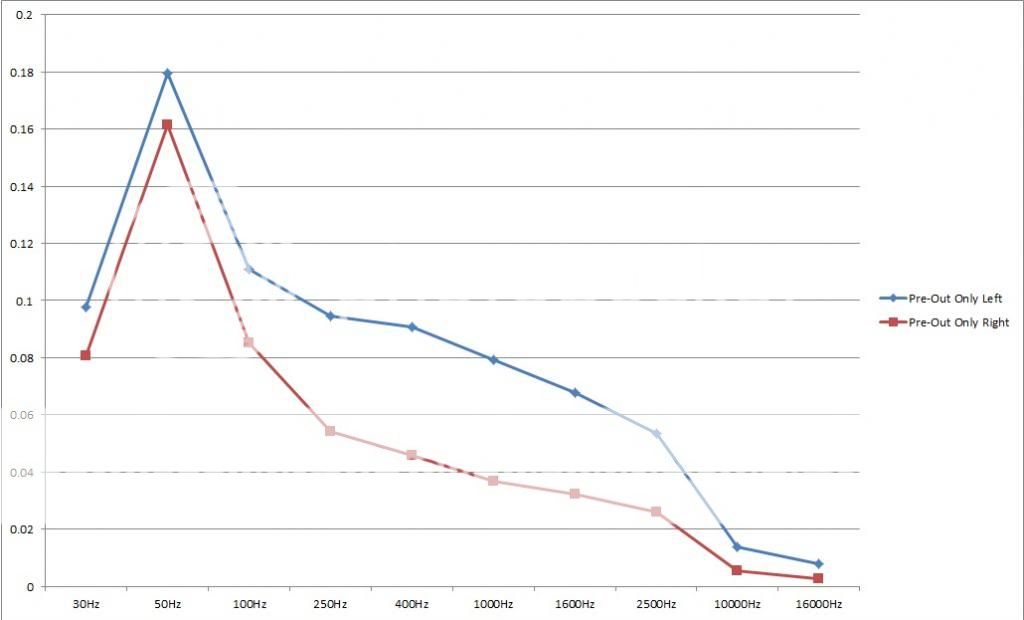
I went ahead and redid the tests, first I did a pre-out test with all the same frequencies we tested with before. I removed the preout/main in jumpers and checked at the preout with the volume control set to half. Here are the preout results.

I can only assume that dropoff at the very end is due to my meter's frequency response...I'm surprised it read as well as it did beyond its spec of 500hz...
Either way... I'm really disappointed that I didn't check this before. Based on these results, I wonder if the problem really does lie within the preamp section. I haven't changed anything about the amp board since the last check that I did, which means that all the diodes are still lifted. I'm tempted to put them back down and check the main in only again....Something tells me that the results will likely be the same.
Either way... I'm really disappointed that I didn't check this before. Based on these results, I wonder if the problem really does lie within the preamp section. I haven't changed anything about the amp board since the last check that I did, which means that all the diodes are still lifted. I'm tempted to put them back down and check the main in only again....Something tells me that the results will likely be the same.
If I'm understanding you correctly, then post #62 is saying that the output from the preamp is different left vs right, and that posts# 63 and 64 appear to show the power amp outputs are identical when fed from the generator.
Is so, then taken at face value it would appear to show a problem with the preamp section but it might not be that clear cut.
What you need to do now is reconfirm that if you swap the pre to power amp feeds over, that the fault swaps channels. If the preamp is the reason then the fault should swap over.
What I'm thinking is this...
The meter may well have a "low sensitivity" on AC and a "sensitivity" that varies with frequency. By sensitivity I mean the load it presents, its input impedance if you like. That would account for greatly varying readings when measuring voltages from a high source impedance even if the basic meter is able to cover a wide frequency range.
Also, the generator will have a low impedance output which could "overcome" any problem in the power amp input stage.
So you must do the recheck of swapping the feeds over again.
Is so, then taken at face value it would appear to show a problem with the preamp section but it might not be that clear cut.
What you need to do now is reconfirm that if you swap the pre to power amp feeds over, that the fault swaps channels. If the preamp is the reason then the fault should swap over.
What I'm thinking is this...
The meter may well have a "low sensitivity" on AC and a "sensitivity" that varies with frequency. By sensitivity I mean the load it presents, its input impedance if you like. That would account for greatly varying readings when measuring voltages from a high source impedance even if the basic meter is able to cover a wide frequency range.
Also, the generator will have a low impedance output which could "overcome" any problem in the power amp input stage.
So you must do the recheck of swapping the feeds over again.
Hmm.. Something bizarre is definitely going on here... So, Here is a chart of three different scenarios. The first, is the OEM metal jumpers going from preout to main in. The second scenario is a set of coax cables going straight across left to left, right to right to account for any differences caused by the coax cables. The third scenario is the same coax cables, swapped preout left to main in right...and vice versa. For all three scenarios, the LH preout provided the same output from the main amp, regardless of which channel was being used. The RH preamp channel on the other hand....it's all over the place. I also noticed an issue where as I was turning up the volume, the RH speaker would be louder, and crackle, then as volume was increased further, it would suddenly clean up on its sound and the voltage would drop off. All along I was thinking the issue was on the LH channel. I'm starting to think its an issue on the RH.
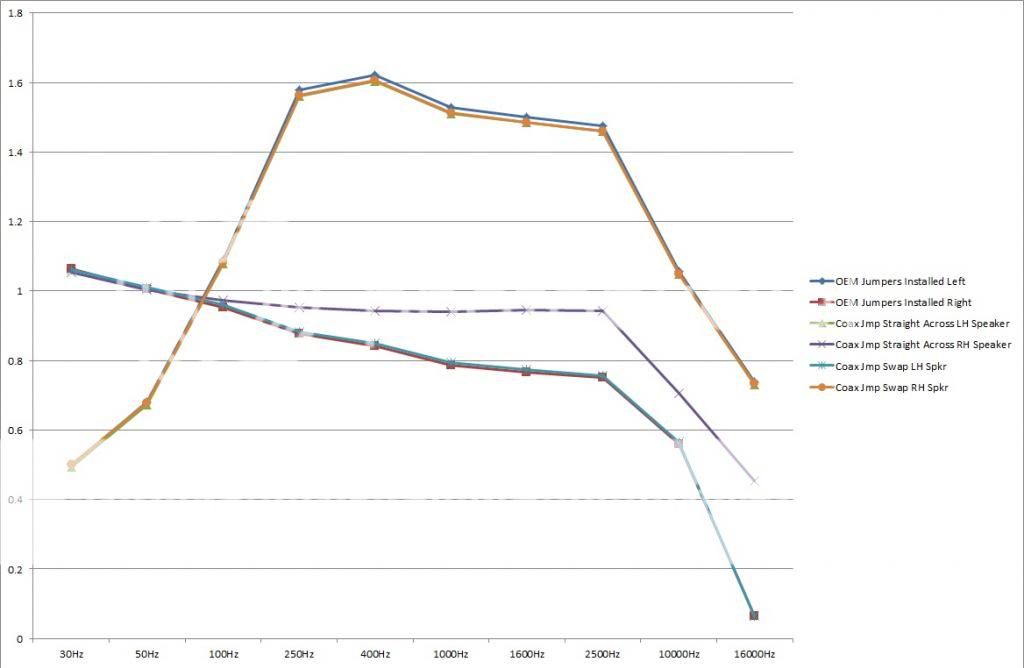

All that points to a preamp fault with a possible second problem of the "crackly sound". Sound that improves with volume can be a symptom of tarnished speaker relay contacts. Thats quite common.
So as a final test if you feed the LH preout into both power amps you should get perfect mono sound from both power amps (of just the left channel content feed). And repeating for the RH preout should give the problem from both power amp outputs.
So as a final test if you feed the LH preout into both power amps you should get perfect mono sound from both power amps (of just the left channel content feed). And repeating for the RH preout should give the problem from both power amp outputs.
Ok, I still have been unable to locate a 7250pe schematic, and I'm on the edge of just buying it... But until I tip over that edge...here's a snapshot of a 7240's preamp section for the LH channel. I looked at the 7250, and without going into indepth comparisons, they appear to have similar device locations and values.
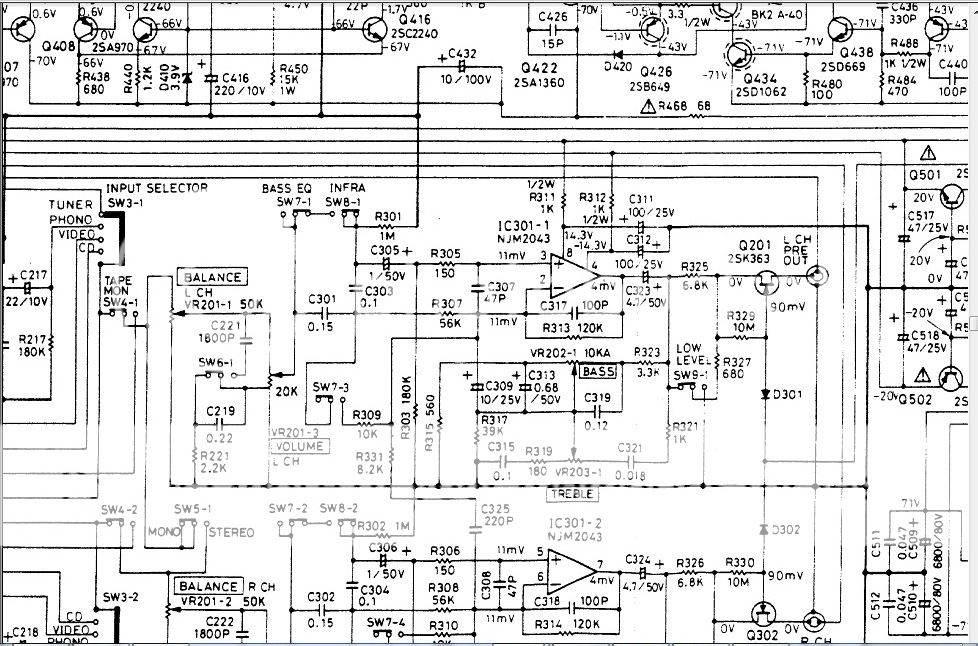

Just found this thread and wondering if the OP got this 7250PE running?
I just picked up a non-working unit that powers up, but no sound. Can't wait to get in a few days, so I can do some basic checking . . . but really glad I found this thread. I'm hoping there will be some similarities that will help me track down and fix this puppy. I may post questions if they make sense in this thread.
I just picked up a non-working unit that powers up, but no sound. Can't wait to get in a few days, so I can do some basic checking . . . but really glad I found this thread. I'm hoping there will be some similarities that will help me track down and fix this puppy. I may post questions if they make sense in this thread.
- Status
- This old topic is closed. If you want to reopen this topic, contact a moderator using the "Report Post" button.
- Home
- Amplifiers
- Solid State
- NAD 7250PE no service manual
